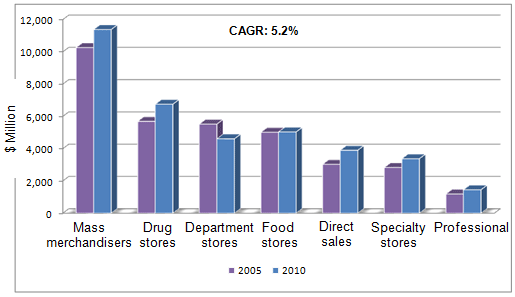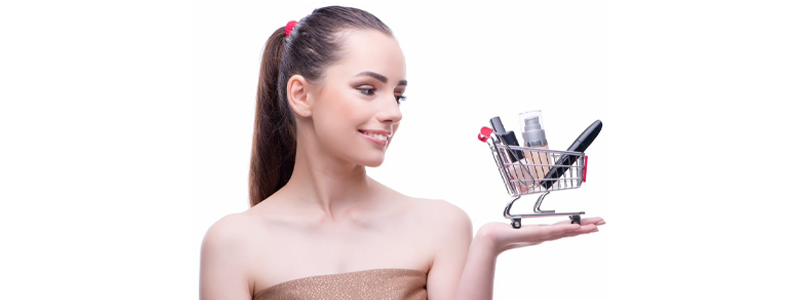Alternate retail channels are white hot in the beauty business, having grown sales nearly $1 billion since 2005. Instead of trying to figure out how to compete, traditional bricks-and-mortar brands should take a page from the alternate channel playbook and leverage these new opportunities to reach customers at their new favorite place to shop: at home.
Sales of cosmetic and toiletry products through alternate channels have exploded over the last five years, fueling a 5.2% growth in direct sales that is outpacing the total market more than three-fold. While conventional person-to-person sales are declining gradually since 2005, multi-media driven channels have snapped up sales, with e-commerce growing by more than 26%, home shopping networks up nearly 20%, and infomercials posting just over 17% growth. This upward trend is expected to continue as mobile technologies, social media, and online deal-hunting converge to help bricks-and-mortar and direct sales-only retailers reach a wider, more diverse, and engaged audience.
Manufacturers’ Sales of Cosmetics and Toiletries by Retail Channel, 2005 and 2010

Faced with increasing competition from alternate channels, bricks-and-mortar stores have looked to physical enhancements to their retail space to build beauty momentum, with upgraded fixtures, increased floor/shelf space, and expanded brand lines. However, while all this revamping has spurred some sales, particularly in the drug store channel, bricks-and-mortar growth remained paltry in comparison to alternate channels. This begs the question: if you can’t beat ‘em, why not join ‘em? Rather than continually try to reinvent themselves to draw customers out of their homes and into the store, perhaps bricks-and-mortar retailers should take a lesson from the alternate channels and look at ways to leverage the tactics that seem to be working so well.
Online Channels Open New Doors
The omnipresence of the Internet combined with the convenience of online shopping have drawn beauty customers to the web in droves. The channel also enables retailers to reach a huge audience with incredibly affordable marketing tactics.
Online stores connect easily and seamlessly with free social media networks like Twitter and Facebook that can be used to build a following, connect with shoppers, and grow loyalty with easily distributed discounts, “how to” tips and other useful content, and special members-only deals. YouTube videos that demonstrate how to use and/or apply products, show before/after results, and incorporate testimonials offer a multi-media appeal that engages shoppers and overcomes the physical/tactile barrier of the Internet.
Some of the big players are working the online angle, but there is definitely room for expansion. RiteAid.com, Walmart.com, and Macys.com now offer e-commerce beauty sales, and Walgreens’ recent purchase of drugstore.com is obviously aimed at capturing this channel. In fact, Walgreens is even experimenting in some markets with a “double-play” of sorts: letting consumers buy online, then pick up their purchases in-store in a bid to work both channels.
However, none of the major retailers seem to have fully tapped the social media potential as of yet, at least specific to their beauty lines. With this option in place, retailers could even easily run their own flash sales (similar to HauteLook, Rue La La, and Gilt Groupe), Tweeting and Facebooking deep-discount, exclusive offers to fans and followers with a built-in sense of urgency that spurs consumers to act now to get in on the special limited-time-only offer.
The Power of the Demo
With more consumers staying at home, either by virtue of unemployment, telecommuting, or simply going out less to save money, the Internet was not the only place for beauty purchases. This dynamic has also helped to boost sales for home shopping networks like HSN and QVC. Combining product quality, value, and selection with information and entertainment, this channel is becoming a growth-leader in the beauty business, leveraging how-to-use and product application demos as an incredibly powerful sales tool.
With a storytelling platform that focuses on problem solving, home shopping channels are able to create a personal connection with consumers, weaving expert advice and customer testimonials into the presentation to help drive viewer engagement and sales in a way that straight-up traditional advertising never could. Luxury brands like Elizabeth Arden and Shiseido have worked with HSN to leverage the power of the demo with special packaging and other promotions exclusive to HSN shoppers, and earlier in 2011, Lancôme launched a new eye cream exclusively on HSN for a limited engagement specifically to demonstrate the product.
But, devoid of a massive television audience, how might bricks-and-mortar retailers leverage the power of the demo to beef up beauty business? In fact, Duane Reade is already making headway with its urban-located Look Boutiques boasting full-time beauty advisors, in-store aestheticians, and other on-site beauty services. The chain (now owned by Walgreens) is banking on its interactive motif, premium brands and upscale décor to attract more shoppers and build beauty sales. Other retailers could launch a similar approach, even if on a limited engagement: a Saturday morning Covergirl eye makeup demo at Rite Aid, for example, or a Lancome-sponsored anti-aging clinic at Macy’s.
Infomercials Tell the Story
Infomercials have also emerged as a beacon of growth in the beauty business. Combining effective storytelling with contemporary celebrity spokespersons, endorsements and abundant customer testimonials, Guthy-Renker is the industry’s powerhouse having pioneered the channel and launched many well-known and successful beauty brands, including ProActiv, Meaningful Beauty, Natural Advantage, Youthful Essence and Wen by Chaz Dean. In fact, its ProActiv acne treatment formula is the company’s largest selling product with $310 million in sales for 2010 introduced through infomercials.
Leveraging the same powerful storytelling model as the home shopping networks, infomercials take a truly multi-channel approach that offers consumers virtually unlimited purchase options. For example, Guthy-Renker’s ProActiv is available through toll-free numbers flashed during the 30-minute spot, by mail order through direct response cards tucked into magazines and coupon mailers, online at the company’s website (complete with video testimonials snipped from the full-length infomercial), and even at vending machines positioned strategically at shopping malls throughout the country.
Without a doubt, diversification is the most powerful lesson for retailers to learn from the infomercial model. The industry has managed to create multiple consumer touchpoints and purchase channels that have made it incredibly easy for consumers to buy no matter what their media preference or location. It is exactly this kind of ubiquity that consumers crave, and retailers must evolve to provide in order to catch shoppers at every available opportunity. stry has managed to create multiple consumer touchpoints and purchase channels that have made it incredibly easy for consumers to buy no matter what their media preference or location. It is exactly this kind of ubiquity that consumers crave, and retailers must evolve to provide in order to catch shoppers at every available opportunity.
The Marriage of Fun and Function
Perhaps more effective than the specific tactics employed by the alternate channels is the overall strategy: make it easy, fun and entertaining to buy. By integrating social media and interactive tools to engage customers in conversation, reach into their homes, and permeate their daily lives, alternate channels are appealing and effective for their immediate call to action and effortless purchasing options that reduce friction for consumers. By taking a lesson from the best practice tactics of the alternate channels, traditional beauty retail channels can use these same tools to marry fun with function and hold onto market share in the digital age.
Karen Doskow, Industry Manager, Consumer Products

